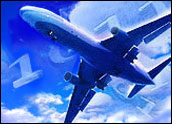
One would almost think we have entered a stage of customer service nirvana: Two industry categories not ordinarily associated with high levels of customer service satisfaction — airlines and fast food — have garnered relatively good scores in a new American Customer Satisfaction Index report.
The operative word here is “relative,” though. The airline industry’s score of 67 is the best it has received in a decade, but considering the scale is 0 to 100, there is plenty of room for improvement.
Another first for the ACSI is the tied score of 80 between sit-down chains and fast food. Usually sit-down chains lead, but over the last year their score dropped by 2.4 percent while fast food chains rose 1.3 percent.
A Closer Look
Scratch behind these numbers, as well as the ones ranking the individual companies in each category, and the reasons for them become clearer. The airline industry, for example, got a boost in its customer service ranking because it pulled up an abysmally low score it received from business travelers in 2011 — it went from 61 to 66 in 2012.
Leisure travelers remained relatively the same at a score of 71. In general, airlines remain in the bottom three among the 47 industries measured by ACSI, along with subscription TV service (66) and newspapers (64).
Also consider the fall of Southwest, an airline that has been a perennial favorite of travelers. It dropped to 77, second now to JetBlue, after 18 years as the No. 1 airline with a score of 81.
“It is notable that they not only declined but by a significant margin as well,” Forrest Morgeson, director for research at American Customer Satisfaction Index, told CRM Buyer.
“The best explanation for this is its recent merger with Air Tran. What we typically see in the wake of any merger of two companies is a drop in customer satisfaction, usually due to glitches in operations or services.”
Last year, for example, Delta’s score tanked after its merger with Northwest. This year, it has rebounded by 16 percent to 65 — which is still low, but no longer last place, as it was in 2011.
Cheap Is Good
An increase in perceived value, along with an improvement in quality, is what pushed the fast food category up the ladder, Morgeson said. In some cases, value — that is, low prices — outweighed the importance of quality.
Papa John’s, the leading provider in this category, rose 5 percent to 83, followed by Little Caesars, which rose 2 percent to 82.
An 83 is a good score for any fast food restaurant, Morgeson said. “Typically, fast food restaurants will see a strong relationship between value for money and satisfaction, and pricing will be more significant than quality alone.”
Papa John’s has customers who are a little more value-sensitive than the industry average, he said, noting that Papa John’s quality score is slightly down this year, but its value portion is up. “It really is a value-driven establishment, and the change in value is the main explanation for the change in satisfaction.”
Papa John’s says both played a role in its reaching the top spot in its category.
“For Papa John’s, quality is a way of life,” spokesperson Tish Muldoon told CRM Buyer. “Our score is a testament to our franchise and our focus on delivering a superior quality product with excellent service.”
One to Watch
One brand that Morgeson plans to watch carefully in the next surveys is hotel chain Starwood, which dropped 5 percent to 75. “That is a big drop, taking it from near the top of the category to close to the bottom.”
Unlike the other examples, it is difficult to put a finger on why Starwood would plummet, other than the fact that it operates so many brands. “We will definitely be watching to see if it continues to drop or not,” Morgeson said.
The ACSI’s June report covered airlines, hotels, full-service restaurants, fast food chains, consumer shipping, and the mail services of the United States Postal Service.






















































